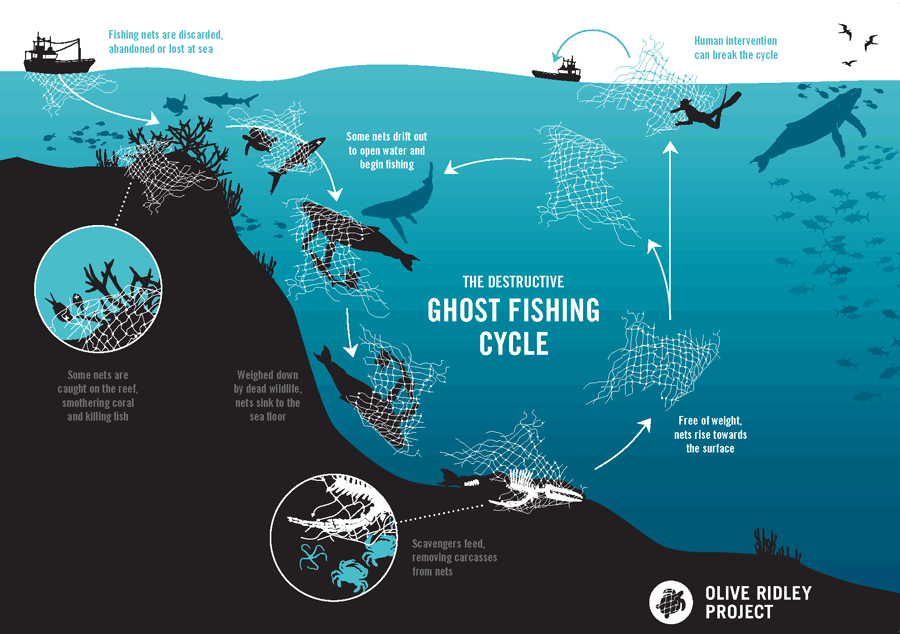Abandoned, lost or discarded fishing nets, or more colloquially referred to as ‘ghost nets’, are an egregious component of wider issues of ‘ghost gear’ which constitute nets, lines, traps and fishing aggregating devices that are no longer utilised and managed by fisheries and fishermen and are unceremoniously dumped into the ocean. With an estimated 700,000 tons of new ghost gear entering the sea yearly, marine biologists term this phenomenon as a ‘global ghost gear’ crisis as an estimated 45% of marine mammals on the IUCN’s (International Union for Conservation of Nature) Red List of Threatened Species have either been harmed or fatally killed by ghost gear (Hancock, 2019). Ghost gear are extremely insidious as they posing threats to marine life as they actively perform their original function and ensnare everything in their path – fishes, dolphins, turtles, sharks and seals to name a few – with the numbers often amounting to hundreds of marine creatures.

As these animals are unable to detect the nets via sonar or sight, they unknowingly swim into the nets which restrict their movement, injure them and prevent mammals especially from rising for air. For pelagics such as whales, these entanglements relegate them to a life sentence of dragging along a proverbial aquatic ball and chain, rendering them to perpetual states of exhaustion, suffocation and deep cuts that at best result in amputated limbs, and at worst, fatalities. Hancock (2019) also argues how ghost gear remnants serve as massive fish traps as the caught animals entice predators who are ultimately captured in ghost gear themselves. When these creatures eventually succumb to death, their decaying carcasses attract scavengers that may also fall victim to these fishing nets/gear. The removal of ghost gear only becomes a possibility when sufficient scavengers feed on rotting carcasses and remove weight from the nets, freeing the nets and allowing them to rise to the surface where humans can effectively remove them from wreaking more havoc in marine ecosystems.

Apart from marine animals, ghost gear also has catastrophic implications for marine ecosystems by damaging boats, devastating shorelines and expediting the spread and pervasiveness of invasive species. With some ghost nets measuring up to 90 kilometers in length and 15 meters in depth, these nets can damage and smother sensitive habitats such as coral reefs by exposing them to disease, destroying them and obstructing reefs’ ability in absorbing oxygen to obtain sunlight (Bittel, 2018). What further aggravates this issue is the fact that ghost nets are also large contributors to the ocean plastic pandemic. A majority of modern nets are made up of plastic compounds and nylon that last for centuries, and comprise of 46% of trash in the Great Pacific Plastic Patch. When these ghost gear eventually disintegrate, they become micro and nanoplastics that are often consumed by marine animals, placing them at higher risks of toxic poisoning and puncturing their internal organs (Bittel, 2018).
While the future may seem bleak, non-profit marine organisation ‘SAVE Coastal Wildlife’ calls on fishermen to exercise more sustainable practices by returning damaged nets and fishing traps to ports for recycling purposes. Moreover, greater awareness about the dangers of ghost nets should be raised and widely circulated in the form of blogs (such as this one), videos and social media posts to encourage more citizen science and collective grassroots action in the form of marine clean-ups to alleviate the prevalence of ghost nets.
References
Bittel, J., 2018. A Single Discarded Fishing Net Can Keep Killing for Centuries. [online] NRDC. Available at: <https://www.nrdc.org/onearth/single-discarded-fishing-net-can-keep-killing-centuries>
Hancock, L., 2019. Our oceans are haunted by ghost nets: Why that’s scary and what we can do | Stories | WWF. [online] World Wildlife Fund. Available at: <https://www.worldwildlife.org/stories/our-oceans-are-haunted-by-ghost-nets-why-that-s-scary-and-what-we-can-do–23>
